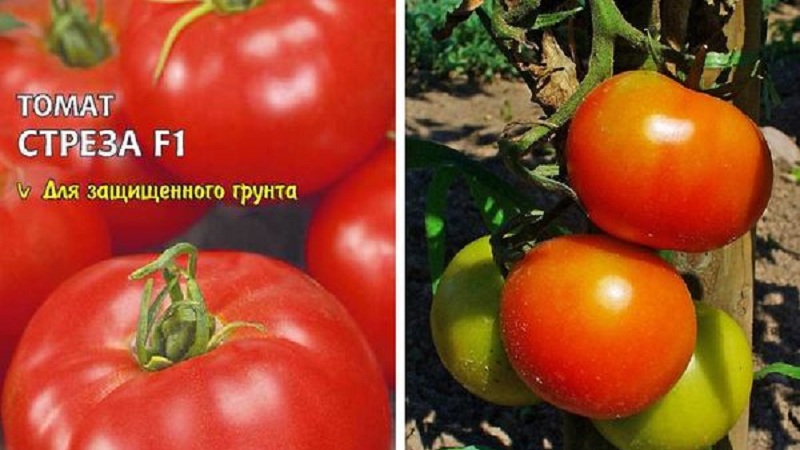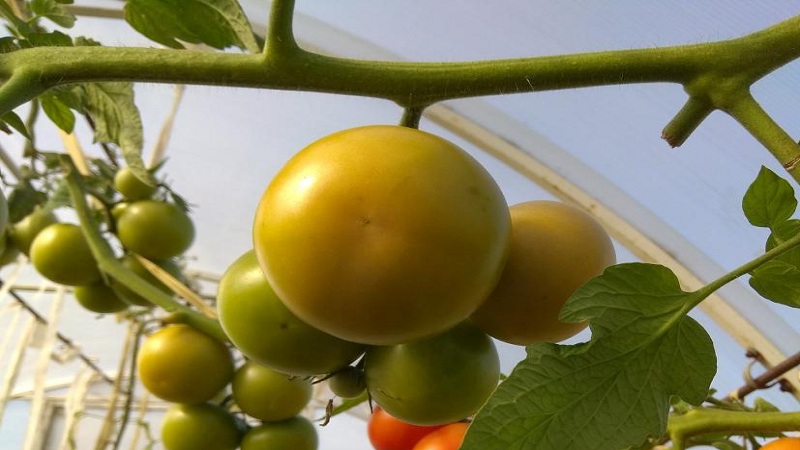High-yielding, tasty and easy-care Stresa tomatoes for outdoor or greenhouse cultivation
The popularity of hybrid tomatoes is growing from year to year. While some gardeners prefer varietal crops, others successfully cultivate hybrids on their plots. Tomato Stresa f1 is one of those. It is appreciated for its ease of care, high productivity and excellent taste.
In this article, we have prepared an overview of the main characteristics of the culture, the pros and cons, the nuances of agricultural technology in greenhouses.
The content of the article
Description of the hybrid
Tomato Stresa f1 is a mid-early hybrid for indoor cultivation. The cultivation was carried out by the biologists of the Semko Junior seed company. The hybrid is recommended for winter-spring and spring-summer turnover.
Indeterminate bushes with an unlimited growth point grow up to 2 m, require removal stepsons and garters to the supports. Plant of compact size, medium internodes. The first inflorescence is formed over 8-9 leaves, the rest - through two leaves. On one hand, 5–7 ovaries are formed.
Photo - hybrid tomato Stresa f1.

The table contains the distinctive features of the tomato.
| Indicators | Characteristic |
| Weight | 180-230 g |
| The form | Flat-round, medium-silver |
| Coloration | Unripe fruits are green with a dark spot near the stalk, ripe fruits are red. |
| Leaves | Medium green |
| Inflorescence | Simple |
| Pulp | Dense, few seeds |
| Taste | Sweet and sour |
| Skin | Dense, smooth and shiny, will not crack. |
| Number of nests | Four or more |
| Peduncle | Articulated |
| Appointment | Universal |
| Ripening period | 95-115 days after germination |
| Yield | 25 kg / m² |
| Sustainability | Tomato mosaic virus, cladosporium, fusarium, verticillus, rootworm nematodes |
| Transportability | High |
How to grow seedlings
The culture is grown through seedlings. Sowing work begins in the second decade of March, 60–65 days before transfer to greenhouses.
Soil preparation and sowing seeds
Before sowing, seeds do not need to be treated with potassium permanganate and soaked in growth stimulants. This is done in production.
A calibration method is used to identify empty grains. The seeds are soaked for 10 minutes in a saline solution (1 tsp in a glass of water at room temperature). Poor quality material will float to the surface, it is not used for sowing. The seeds remaining at the bottom of the glass are washed with warm running water.
The soil for growing seedlings is prepared from equal parts of turf, peat and river sand with the addition of superphosphate (40 g per bucket of soil mixture). They also use a ready-made substrate in bags for growing seedlings of peppers and tomatoes. Such soil is already enriched with nutrients.
Before use, the soil is disinfected in an oven, a double boiler, and treated with a solution potassium permanganate or "Fitosporin M". The procedure prevents the development of bacteria and fungi in the soil.
For sowing seeds, use cassettes, boxes, plastic trays, pots, tetrapacks from juice or milk. The seeds are placed in moist soil to a depth of 2 cm with an interval of 2-3 cm. A film is pulled from above to create greenhouse conditions and the containers are taken to a dark, warm place. The seeds hatch in 4-5 days at a temperature of +25 ° C.
Care
After the emergence of seedlings, the film is removed, and the containers are taken out to a lighted place. Daylight hours should be at least 15-16 hours.To prevent the seedlings from growing and gaining strength faster with a lack of sunlight, fluorescent lamps are installed above it.
Seedlings do not like overflow, therefore, instead of a watering can, they use a spray bottle.
At the stage of 2-3 leaves, seedlings dive into individual pots made of plastic or peat. A week after picking, the seedlings are fed once with "Effekton" or "Agricola".
It is easy to prepare universal foliar and root dressing at home:
- 20 g superphosphate;
- 10 g of potassium sulfate;
- 5 g of urea.
Reference. A week before being transferred to the greenhouse, the seedlings are brought out daily for half an hour to the balcony for hardening.
How to grow tomatoes
Hybrid Stresa f1 is grown in greenhouses according to standard methods. The soil and greenhouses are prepared in the fall. In the spring, re-loosening is carried out and fertilized with humus. Indeterminate plants need pinching, garter, moderate watering and application of organic and mineral fertilizers.
Landing
The transfer of mature seedlings to a permanent place is carried out in mid-May. The soil is dug up in the fall, the plant residues are removed along with the roots and brought in a bucket of humus per 1 m². At the beginning of spring, the soil is loosened and fertilized with humus - 10 liters per square meter.
Wells 20 cm deep are dug in a checkerboard pattern every 40 cm. The distance between the rows is 70 cm. Boiling water is poured into each hole, a handful of wood ash and a tablespoon of superphosphate are added. The seedlings are abundantly moistened with warm water and planted in the holes.
Reference. There are 3-4 tomato bushes per 1 m².
Care
After planting, the soil is covered with black agrofibre to prevent the growth of weeds, the spread of fungi and bacteria, and to reduce labor costs for caring for tomatoes. Instead of synthetic fiber, straw, peat, sawdust, coniferous needles are used.
The bushes are formed into two stems by removing young shoots after the fifth brush and tied to high wooden supports or trellis. The procedure stimulates the formation of ovaries and increases the yield.
Tomatoes prefer moderate watering with warm rain or settled water at the root in the morning or evening. Installing a drip irrigation system will help optimize plant care.
Young bushes need about 5 liters of water, adults - 10 liters. Watering frequency is once every 10-12 days.
The Stresa hybrid needs regular feeding with organic and mineral compounds. During the growing season, plants are fertilized 3-4 times. The first organic feeding is carried out two weeks after planting. An infusion of chicken manure (20 g per 10 l of water) or mullein (1 l of infusion per 10 l of water) is suitable for this. Ready-made organic fertilizers are popular: "Piksa", "Vermix", "Ripen-ka", "Reliable".
14 days after the introduction of organic matter, the bushes begin feed mineral complexes during the flowering period, the formation of ovaries and at the beginning of fruiting: "Kemira", "Universal", "Solution". Their main advantage is their balanced composition, eliminating the need to prepare the mixture yourself. The manufacturer indicates the consumption and frequency of use on the packaging.

Features of cultivation in closed and open ground
When cultivating Stresa tomato in a greenhouse, maintain a humidity level of 65–70%. Excessive moisture causes the pollen to stick together. In low humidity, pollen scatters and does not fall on the pistil. In both the first and second cases, pollination is difficult or does not occur at all.
Despite the manufacturer's recommendations, in the southern regions, the culture is grown in open areas. Agrotechnology of tomatoes is no different from growing in greenhouses. The culture tolerates heat and cold, rarely gets sick. At the same time, yield indicators decrease, but the taste and presentation of the fruits remain at a high level.
Diseases and pests
The hybrid has strong immunity to the tomato mosaic virus, cladosporium, fusarium, verticillium and rootworm.
For prevention late blight (brown spots on the stems, leaves, tomatoes, whitish bloom on the back of the leaves) the bushes are sprayed with Fitosporin, a solution of whey (100 ml per 1 l of water), the soil is mulched with sawdust, hay or needles, and the optimum moisture level in greenhouses is maintained.
To get rid of aphids, spider mites, whiteflies, Colorado potato beetles, gnawing scoops will help drugs "Confidor", "Borey", "Flumite", "Iskra", "Aktarra", "Epin", "Comandor", "Decis Profi".
Slug harvested by hand at night or sprayed plants with a solution of ammonia (4 tablespoons per 10 liters of water).
Council. To attract beneficial insects, plant mustard, marigold, chamomile, basil fennel, mint next to tomatoes.
Harvesting and application of the crop

The first tomatoes ripen approximately 90–95 days after full germination. Consumers and farmers alike appreciate the taste of vegetables. The fruits are large, fleshy, juicy and aromatic.
Good in seasonal vegetable salads and pickled. They make delicious and rich tomato juice, pasta, sauces, adjika, lecho, soups, borsch dressing.
Advantages and disadvantages
Hybrid advantages:
- immunity to tomato diseases;
- unpretentious care;
- high productivity;
- fruits are large and leveled;
- high level of transportation;
- excellent taste and aroma;
- universal use in cooking.
disadvantages:
- tall bushes require pinching, shaping and garters;
- in the open field, yield decreases.
Reviews
The hybrid is liked by many gardeners for its undemanding care, resistance to bad weather and diseases, high productivity and pleasant taste.
Irina, Kstovo: «Stresa planted tomatoes for the first time last year in a greenhouse. The characteristics correspond to those stated on the package. I removed the bushes in two stems, moderately moistened, fed with ready-made liquid fertilizers. Given the low labor costs, she received a rich harvest. I sold some of the tomatoes, and some rolled them up in jars for the winter.
Yaroslav, Novovoronezh: “I have been growing Stresa in a greenhouse for four years in a row. Every time I get the fruits of excellent quality. I collect about 20 kg from one square meter. The hybrid is pleasant because it does not need special care. I organized drip irrigation in the greenhouse and apply fertilizers once every two weeks. This is enough to get a big harvest. "
Vasily, Kirov: “In our climatic zone, tomatoes can only be planted in greenhouses. Seedlings of the Stresa hybrid last year were shared by a neighbor in the country. I was just looking for a fruitful tomato to grow for sale. I was surprised by the high productivity of the crop with minimal maintenance. The taste of the fruit is sweet, with a slight sourness. Tomatoes are suitable for fresh consumption and preparation for the winter. "
Conclusion
The Stresa hybrid is one of the best tomatoes for beginners. Biologists have tried to collect in culture the best characteristics of the ancestors to obtain excellent results.
It is not difficult to care for tall plants - it is enough to regularly remove young shoots, form bushes into two stems, tie up heavy brushes in a support, water moderately, fertilize with organic matter and mineral components. With the right approach, about 25 kg of selected tomatoes are harvested from one square meter.